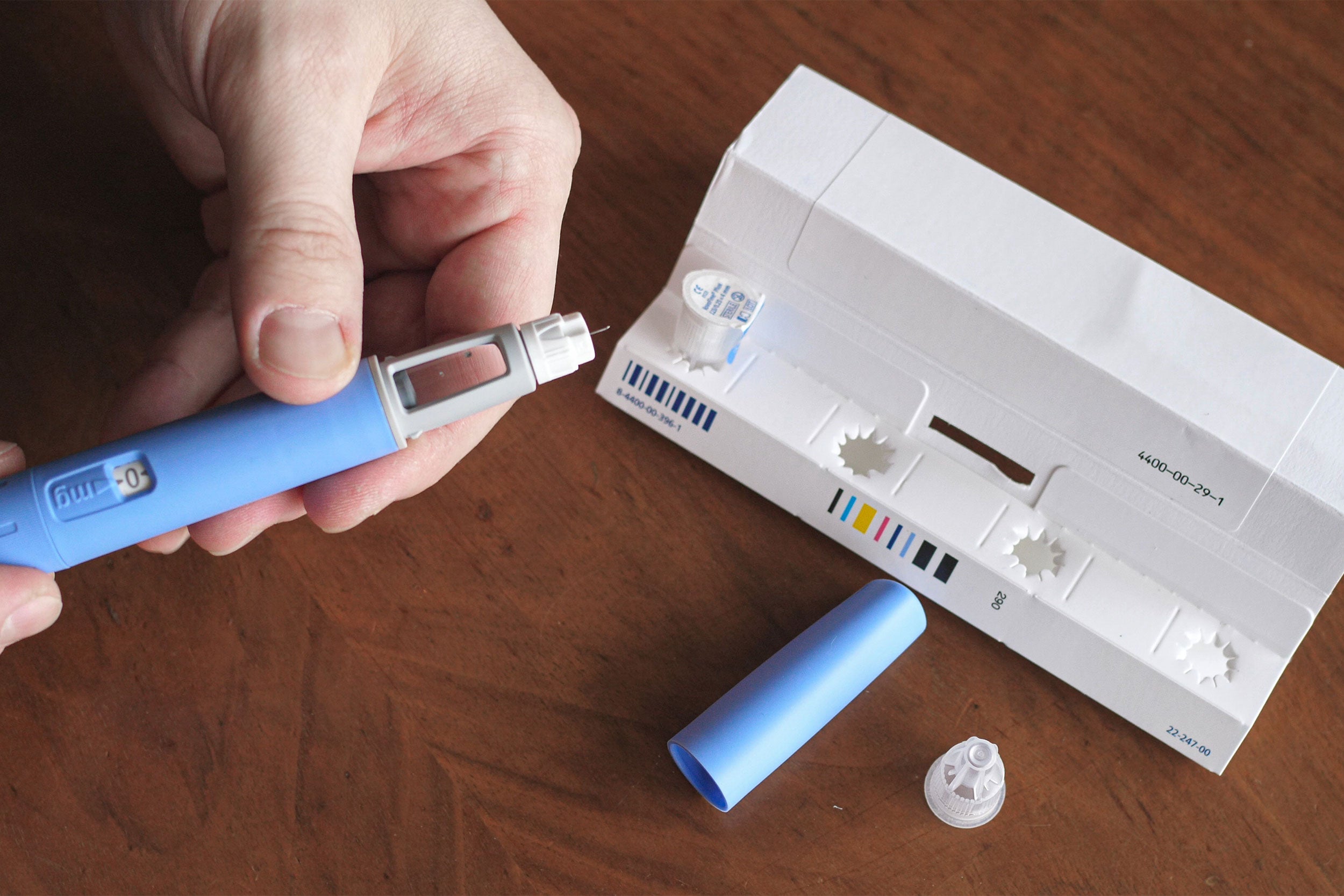
Ozempic, one of the drugs developed for Type 2 diabetes, caught the attention of the public and drug makers after it proved to help patients shed pounds.
iStock by Getty Images
Health
Are new weight-loss drugs the answer to America’s obesity problem?
Some doctors call them a godsend, particularly as part of wider treatment plan; others warn against halting research into root causes
A new generation of anti-obesity drugs has shifted the treatment landscape, providing potent new therapies to achieve weight loss but sparking debate about how best to use them and the proper place for lifestyle-based interventions that long had been center stage.
The drugs, called GLP-1 receptor agonists, were developed to treat Type 2 diabetes, the prevalence of which has skyrocketed in recent decades along with rates of obesity in America. Besides blood sugar control, however, these medications result in weight loss, an effect that has caught the eye of both the public and drug makers, who have moved to create specific formulations to help patients shed pounds.
Overall these compounds have proven startlingly effective, shown to help patients shed 10 percent to 22 percent of body weight in their first year of use. They work by mimicking a hormone called glucagon-like peptide-1, which slows digestion and depresses appetite. The treatments have been greeted as a godsend by patients discouraged after years of ineffective dieting and as a potent new option by some obesity specialists whose toolkit has long been restricted to bariatric surgery — effective but invasive and in many cases irreversible — older, less effective medications, and lifestyle-based approaches such as diet and exercise that have so far proven to be effective over the long term for just about 10 percent of patients.
Fatima Cody Stanford, an obesity specialist at Massachusetts General Hospital and associate professor of medicine and pediatrics at Harvard Medical School, said that for most patients with severe obesity, lifestyle approaches aren’t up to the task. She described them as akin to trying to clear a major snowstorm with a shovel instead of a snowplow. The new medications, particularly when coupled with bariatric surgery, are tools of appropriate power to address a problem that has proven resistant to change and comes with increased risk of life-threatening conditions such as high blood pressure, diabetes, and fatty liver disease, she said.
“Patients would come in weighing 350 to 400 pounds, and we were just telling them to drink skim milk, increase your walking, things of the sort that didn’t have any impact …”
— Fatima Cody Stanford

Jon Chase/Harvard Staff Photographer
“As someone who was eager to care for this patient population, I was just told to give more dietary strategies,” Stanford said of her training. “Patients would come in weighing 350 to 400 pounds, and we were just telling them to drink skim milk, increase your walking, things of the sort that didn’t have any impact on the degree of severity of their disease.”
Other experts applaud the new drugs as an effective new tool but warn against abandoning efforts to first understand the roots of the obesity crisis — which most agree has resulted from changes in modern life, diet, and activity levels — and addressing those underlying factors. Only by taking those on, they argue, can the nation reverse increases in obesity, diabetes, and other associated conditions.
David Ludwig, an obesity specialist in the New Balance Foundation Obesity Prevention Center at Boston Children’s Hospital and professor of pediatrics at Harvard Medical School and of nutrition at the Harvard T.H. Chan School of Public Health, wrote a May opinion piece in the Journal of the American Medical Association arguing that, though diet- and exercise-based approaches appear to be effective for a minority of patients, investigations into such approaches have been hamstrung for decades by a lack of resources. While major pharmaceutical companies have spent billions developing the new GLP-1 agonists, the National Institutes of Health doled out just $250 million in 2022 to scientists across the country to investigate childhood obesity, an amount equivalent to a single, Phase 3 drug trial.
“Big pharma can come up with a billion dollars to take a promising drug through Phase 3 clinical trials without difficulty because the profits can be enormous, whereas researchers trying to understand the environmental and dietary drivers of obesity must manage with a shoestring budget,” Ludwig said. “It’s not surprising we’re left with weak interventions. Most dietary clinical trials are small, low-intensity, and low-quality — a hundred of these can’t produce the knowledge of one good study.”
In their JAMA Viewpoint article, Ludwig and co-author Jens Holst of the University of Copenhagen argue that diet- and lifestyle-based approaches should be at the forefront of obesity prevention and treatment. Some diets, in particular those with low glycemic load that restrict processed carbohydrates, have shown promise when coupled with intensive behavioral interventions. One trial showed an average 12 percent weight loss among patients with Type 2 diabetes after a year. Despite those results, with a few exceptions, expensive, high-quality trials that can provide conclusive answers still need to be undertaken.
Ludwig said the resource problem stems from misaligned incentives. Adult obesity rates have risen from 10 percent in 1970 to more than 40 percent today, but financial support for investigating its causes has been relatively meager because few wealthy companies stand to profit if Americans eat better and increase physical activity. By contrast, deep-pocketed companies eyeing the market for obesity drugs see an enormous potential customer base, already enthusiastic about the new medications, which can be taken for a lifetime to keep weight off.
“Big pharma can come up with a billion dollars to take a promising drug through Phase 3 clinical trials … whereas researchers trying to understand the environmental and dietary drivers of obesity must manage with a shoestring budget.”
— David Ludwig

File photo by Kris Snibbe/Harvard Staff Photographer
An illustration of that enthusiasm came this spring, when social media came alive as celebrities such as Elon Musk told of relatively easy weight loss after taking the new medications. Such “off-label” use by wealthy celebrities looking not to treat obesity but to drop a few excess pounds is legal but can deplete supplies for those who need it most. Demand so outstripped supply in May that drug maker Novo Nordisk, maker of the diabetes drug Ozempic and its weight-loss counterpart Wegovy, announced it was limiting Wegovy supplies for new patients.
“With availability of new powerful drugs and surgical procedures, the incentives are to promote them. They’re huge moneymakers for drug companies, surgeons, and hospitals,” Ludwig said. “We tend to lose sight of lifestyle and dietary interventions because few influential organizations profit in the same way. Beyond generic interventions like making physical activity more convenient, we must take a more sophisticated approach to investigating the biological effects of diet. The type of foods we eat alter dozens of hormones, hundreds of metabolic pathways, and the expression of myriad genes throughout the body in varying ways. Knowledge of these effects, combined with intensive behavioral methods, could inform the design of effective alternatives to drugs and surgery for prevention and treatment.”
Walter Willett, professor of nutrition at the Harvard T.H. Chan School of Public Health, sees two pathways ahead. On one, the new drugs help people with severe obesity lose meaningful amounts of weight, which then increases chances of success of lifestyle-based approaches. On the other, people don’t improve their diet, don’t increase exercise, and use the drugs to counter unhealthy habits they maintain and that may have contributed to the problem. On this path, people’s health would still be poor because good lifestyles contribute to well-being in many ways unrelated to weight control, Willett said.
“So, which path will we go down? I suspect it’s not going to be simple,” Willett said. “One thing for sure is that this is the Holy Grail for Big Pharma. You have two-thirds of the population overweight or with obesity and eligible to take this drug class, at somewhere around $10,000 to $15,000 a year for life.”
Either way, drug companies will be among the winners, Willett said. His “back of the envelope” calculation is that the new weight-loss drugs have the potential to add 50 percent to U.S. healthcare costs, which already eat up 20 percent of the gross national product, double that of most other countries.
“You can see this ballooning completely out of control,” Willett said. “Even today, healthcare costs are displacing the true determinants of health, which are education, a safe environment, physical infrastructure to work, play, walk, bike, all of that. Those are being squeezed and displaced by healthcare costs.”
“It’s no big surprise or mystery why we have such a problem of obesity. … we continue to let children be exploited by the beverage and food industry for profit, even though we know it’s contributing to mortality and suffering.”
— Walter Willett

File photo by Stephanie Mitchell/Harvard Staff Photographer
In January, the nation’s largest association of pediatricians stoked the debate through new clinical practice guidelines that emphasized both drugs and bariatric surgery for treatment of children with obesity and severe obesity. The American Academy of Pediatrics’ guidelines call obesity and overweight “one of the most common pediatric chronic diseases in the U.S.,” affecting some 14.4 million children and adolescents.
The guidelines say that pediatricians should offer weight-loss drugs to adolescents age 12 and older who have obesity, as an adjunct to health behavior and lifestyle treatment. Similarly, they say pediatricians should offer adolescents age 13 and older with severe obesity an evaluation for metabolic and bariatric surgery.
Stanford, who is on the executive committee of the AAP’s section of obesity, said that the new guidelines are the first in 16 years and shift away from a prior approach that counseled “watchful waiting” while lifestyle and diet-related changes were tried.
That strategy didn’t work for most patients, said Stanford, who did not have a hand in writing the new guidelines. The recommendations are intentionally comprehensive, she said, and aim to reduce not just obesity but also its associated diseases early in life. By minimizing damage to organs from conditions like high blood pressure and diabetes, the body has a much greater chance to recover than it would after decades of trying other strategies.
“The impetus behind the change in the guidelines was that the earlier intervention is key,” Stanford said.
Even those cautious about how the new drugs are deployed acknowledge their potency. The question, they say, isn’t whether they should be used, but how and in what combination with other approaches like bariatric surgery, diet, exercise, and intensive nutritional, behavioral, and family support.
In addition, they point out, there remain questions of exacerbating inequality in places where the medications aren’t covered by insurance and still-unknown side effects from long-term use, since some patients may need to be on the drugs for a lifetime to avoid regaining weight.
One problem the drugs can’t address, however, is the nature of the nation’s food environment. Willett and Lillian Cheung, lecturer on nutrition and director of mindfulness research and practice at the Harvard Chan School, said one reason for the obesity epidemic is the prominence of unhealthy, highly processed foods on the nation’s tables.
“It’s no big surprise or mystery why we have such a problem of obesity,” Willett said. “During childhood, we continue to let children be exploited by the beverage and food industry for profit, even though we know it’s contributing to mortality and suffering.”





